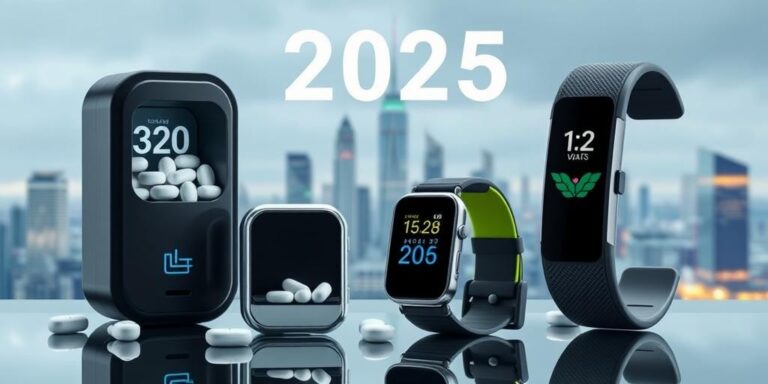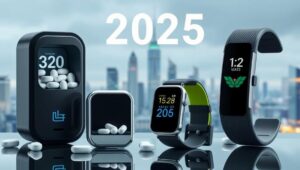Drug Management and Adherence with Smart IoT Devices (2025)
As we advance into 2025, the integration of smart IoT (Internet of Things) devices in healthcare is becoming increasingly sophisticated. One of the most promising applications is in drug management and adherence, where IoT devices are revolutionizing how patients take their medications, leading to improved health outcomes and reduced healthcare costs.
The Current Landscape of Medication Adherence
Medication non-adherence is a widespread problem. Studies show that approximately 50% of patients do not take their medications as prescribed. This can result in:
- Worsening of chronic conditions
- Increased hospitalizations
- Higher healthcare expenditures
- Reduced quality of life
Traditional methods to improve adherence, such as reminders, counseling, and packaging solutions, have had limited success. This is where smart IoT devices come into play, offering a more dynamic and personalized approach.
How Smart IoT Devices Are Changing Drug Management
Smart IoT devices are designed to monitor and manage medication intake in real-time. These devices use various sensors and connectivity features to ensure patients adhere to their prescribed regimens. Here are some key applications:
- Smart Pill Dispensers: These devices automatically dispense the correct dosage of medication at the scheduled time. They can be programmed with the patient’s prescription and send reminders via mobile apps or voice assistants. If a dose is missed, the dispenser can alert caregivers or healthcare providers.
- Ingestible Sensors: These tiny sensors are embedded in pills and transmit data to a wearable patch or mobile device once ingested. They confirm that the medication has been taken and can also monitor physiological responses to the drug.
- Connected Wearable Devices: Smartwatches and fitness trackers can be integrated with medication management systems. They provide reminders, track medication adherence, and monitor vital signs that may be affected by the medication.
- Smart Packaging: Medication packaging equipped with sensors can track when a pill is removed. This information is logged and can be shared with healthcare providers to monitor adherence and adjust treatment plans as needed.
- Mobile Apps and Platforms: These serve as the central hub for managing medications. They provide reminders, educational content, and communication channels for patients, caregivers, and healthcare providers.
Benefits of Smart IoT Devices in Drug Management
The adoption of smart IoT devices in drug management offers several benefits:
- Improved Adherence: Real-time monitoring and reminders significantly improve medication adherence rates.
- Personalized Treatment: Data collected by IoT devices enables healthcare providers to tailor treatment plans to individual patient needs.
- Remote Monitoring: Healthcare providers can remotely monitor patients’ medication adherence and intervene when necessary, reducing the need for frequent in-person visits.
- Data-Driven Insights: The data generated by these devices provides valuable insights into medication effectiveness and potential side effects.
- Enhanced Patient Engagement: User-friendly apps and devices empower patients to take control of their health and actively participate in their treatment.
Challenges and Considerations
Despite the numerous benefits, there are challenges to consider when implementing smart IoT devices for drug management:
- Data Security and Privacy: Ensuring the security and privacy of patient data is crucial. Robust encryption and compliance with data protection regulations are essential.
- Cost: The cost of IoT devices and related services can be a barrier to adoption, particularly for low-income patients. However, the long-term benefits of improved adherence and reduced healthcare costs may outweigh the initial investment.
- Integration with Healthcare Systems: Seamless integration with existing electronic health record (EHR) systems is necessary to ensure that data is readily accessible to healthcare providers.
- User Adoption: Some patients may find it challenging to use new technologies. User-friendly designs and comprehensive training are essential to promote adoption.
The Future of Drug Management with IoT
Looking ahead, the future of drug management with IoT is promising. Advancements in sensor technology, artificial intelligence, and connectivity will further enhance the capabilities of these devices. Imagine a future where:
- AI-powered systems predict medication adherence based on patient behavior and provide personalized interventions.
- Nanotechnology enables the development of even smaller and more sophisticated ingestible sensors.
- Blockchain technology ensures the security and transparency of medication data.
Conclusion
Smart IoT devices are set to transform drug management and adherence, leading to improved health outcomes, reduced healthcare costs, and enhanced patient engagement. While challenges remain, the potential benefits are significant, making it an exciting area of innovation in healthcare. As we move closer to 2025, expect to see even more widespread adoption of these technologies, paving the way for a healthier future.




